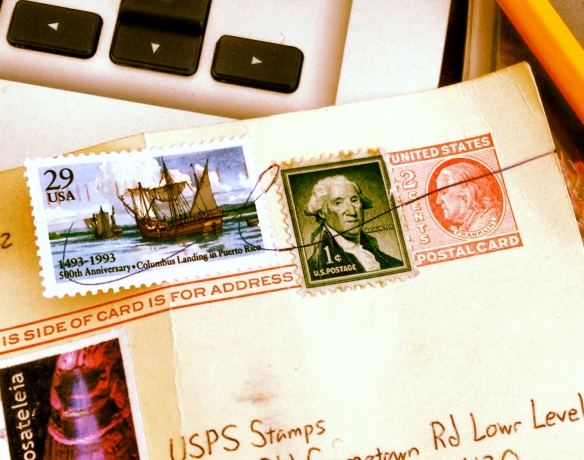One of the most unique paintings featured on the Modern Art in America stamp sheet is I Saw the Figure 5 in Gold, by Charles Demuth. The work is actually a “poster portrait” of Demuth’s friend William Carlos Williams, who is honored on the 2012 Twentieth-Century Poets stamp sheet.
Williams had written a poem, “The Great Figure,” about a fire truck speeding noisily through the streets in the rain with siren blaring, wheels rumbling, and gong clanging. Some lines from that poem (“I saw the figure 5 / in gold / on a red / firetruck”) gave Demuth the title for his painting. Produced in 1928, in oil, graphite, ink, and gold leaf on paperboard, the painting transmits the speed and—some feel—even the noise of the poem by Williams.
 Whether or not it makes viewers hear the siren, the painting is a witty homage to Demuth’s friend. The words “Bill” and “Carlos” appear—the latter on a theater marquee in the background—and the poet’s initials are painted at the bottom. In a sly, self-referential joke, the fire engine in Demuth’s painting is speeding past a store window bearing the legend “ART Co.” The work prefigures Pop art and speaks to the way the arts (in this case, painting and poetry) can influence each other.
Whether or not it makes viewers hear the siren, the painting is a witty homage to Demuth’s friend. The words “Bill” and “Carlos” appear—the latter on a theater marquee in the background—and the poet’s initials are painted at the bottom. In a sly, self-referential joke, the fire engine in Demuth’s painting is speeding past a store window bearing the legend “ART Co.” The work prefigures Pop art and speaks to the way the arts (in this case, painting and poetry) can influence each other.
Between 1923 and 1929, Demuth painted a series of “poster portraits” for which he used symbols, objects, and typography to portray his friends, rather than their physical likeness. In addition to Williams, by then a publishing poet as well as a doctor, Demuth made portraits of Georgia O’Keeffe, John Marin, Arthur Dove, and others.
The were issued March 7, 2013, and are currently available online and in Post Offices around the country. The Twentieth-Century Poets Forever® stamps were issued April 21, 2012, and can be purchased online.

 To evoke the look of Civil War-era broadsides, Emancipation Proclamation stamp art director Antonio Alcalá and
To evoke the look of Civil War-era broadsides, Emancipation Proclamation stamp art director Antonio Alcalá and 

